GIGABYTE Z97X-UD5H Review: Choose Your Storage Option
by Ian Cutress on May 14, 2014 9:00 AM EST- Posted in
- Motherboards
- Intel
- Gigabyte
- Z97
Scientific and Synthetic Benchmarks
2D to 3D Rendering –Agisoft PhotoScan v1.0: link
Agisoft Photoscan creates 3D models from 2D images, a process which is very computationally expensive. The algorithm is split into four distinct phases, and different phases of the model reconstruction require either fast memory, fast IPC, more cores, or even OpenCL compute devices to hand. Agisoft supplied us with a special version of the software to script the process, where we take 50 images of a stately home and convert it into a medium quality model. This benchmark typically takes around 15-20 minutes on a high end PC on the CPU alone, with GPUs reducing the time.
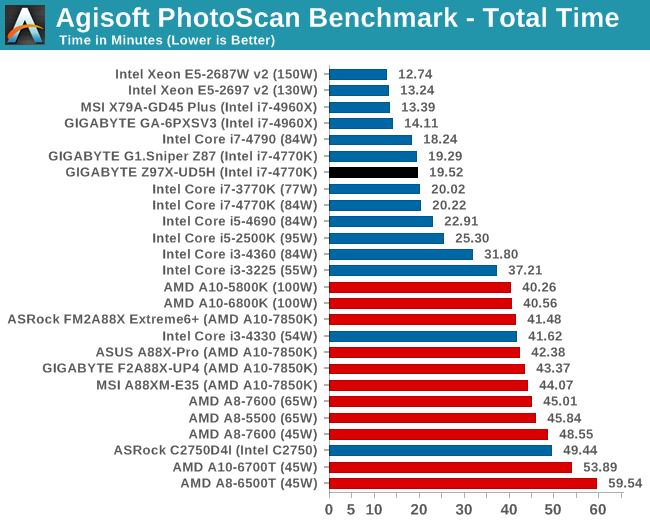
Console Emulation –Dolphin Benchmark: link
At the start of 2014 I was emailed with a link to a new emulation benchmark based on the Dolphin Emulator. The issue with emulators tends to be two-fold: game licensing and raw CPU power required for the emulation. As a result, many emulators are often bound by single thread CPU performance, and general reports tended to suggest that Haswell provided a significant post to emulator performance. This benchmark runs a Wii program that raytraces a complex 3D scene inside the Dolphin Wii emulator. Performance on this benchmark is a good proxy of the speed of Dolphin CPU emulation, which is an intensive single core task using most aspects of a CPU. Results are given in minutes, where the Wii itself scores 17.53; meaning that anything above this is faster than an actual Wii for processing Wii code, albeit emulated.
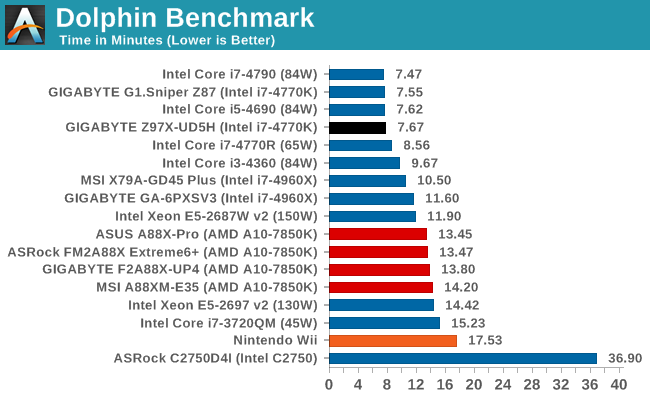
Point Calculations – 3D Movement Algorithm Test: link
3DPM is a self-penned benchmark, taking basic 3D movement algorithms used in Brownian Motion simulations and testing them for speed. High floating point performance, MHz and IPC wins in the single thread version, whereas the multithread version has to handle the threads and loves more cores.
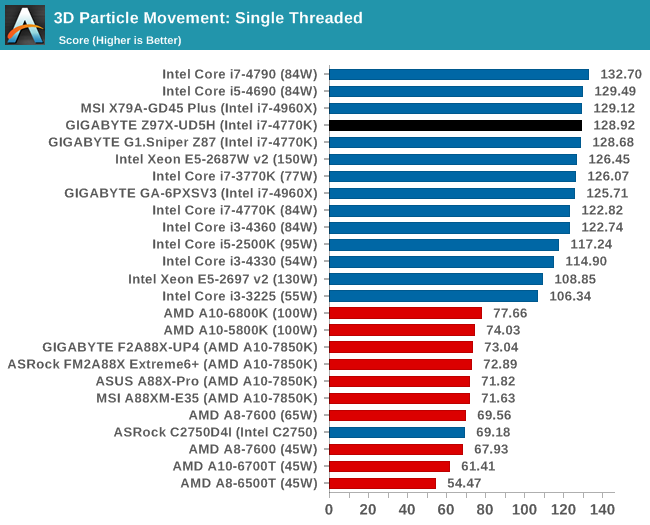
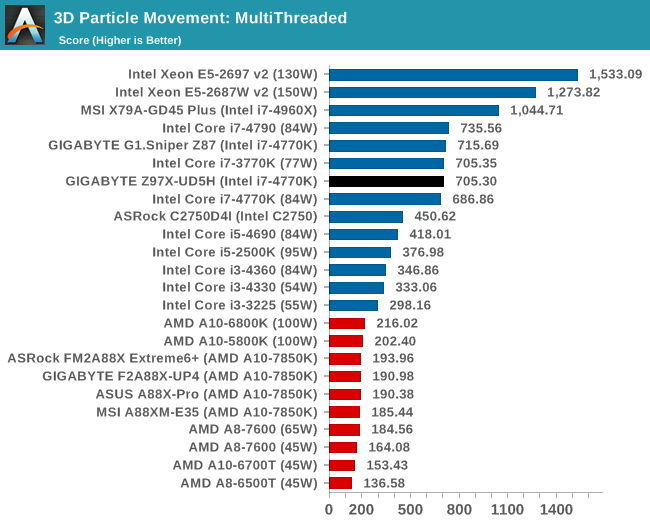
Encryption –TrueCrypt v0.7.1a: link
TrueCrypt is an off the shelf open source encryption tool for files and folders. For our test we run the benchmark mode using a 1GB buffer and take the mean result from AES encryption.
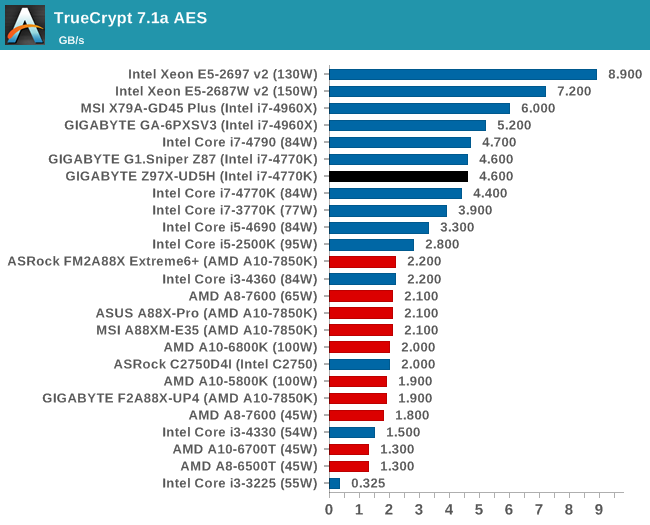
Synthetic – 7-Zip 9.2: link
As an open source compression tool, 7-Zip is a popular tool for making sets of files easier to handle and transfer. The software offers up its own benchmark, to which we report the result.
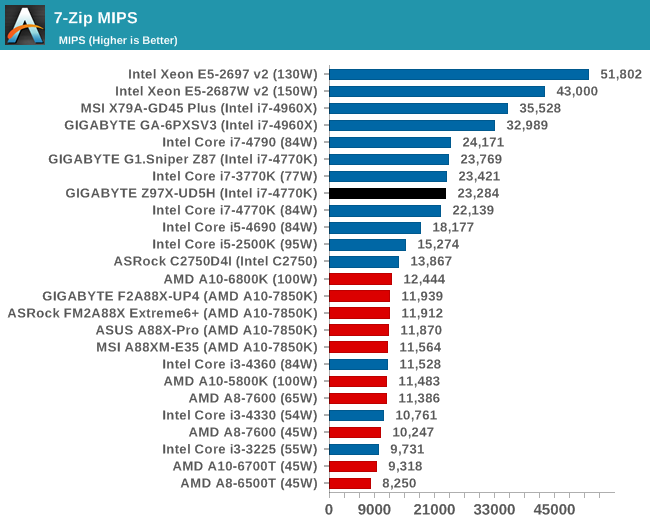










53 Comments
View All Comments
The_Assimilator - Thursday, May 15, 2014 - link
A: By that argument every chipset ever made should still support ISA.B: The Flex IO diagram on this very page specifically states "Total of 14 USB2 ports". I'm reading that as being a constant entirely independent of the number of USB 3.0 ports, but if you have any literature to contradict that, I'd be appreciative if you could link it.
repoman27 - Thursday, May 15, 2014 - link
Not sure I follow your logic. USB is probably the most used feature of a modern chipset (I suppose SATA probably gives it a run for its money though). Take a look at any USB 3.0 connector and you'll find 5 contacts which correspond to the SuperSpeed transmit and receive signaling pairs and ground, and then 4 more that carry the USB 2.0 signal and Vbus. This is how USB 3.0 achieves SuperSpeed while maintaining backwards compatibility, and the signals all need to come from somewhere.Intel hasn't posted datasheets for the 9 series chipsets yet, but there really isn't a heck of a lot of difference between them and the 8 series (in fact they're all currently listed in ARK under the "Products (Formerly Lynx Point)" heading). In the 8 series datasheet [ http://www.intel.com/content/dam/www/public/us/en/... ], however, Intel states: "xHCI USB controller provides support for up to 14 USB ports, of which six can be configured as SuperSpeed USB 3.0 ports." Intel also includes this additional note: "Some USB 3.0 motherboard down devices do not require support for USB 2.0 speed and it is possible to route only the SuperSpeed signals, as allowed by the USB 3.0 specification. In this special case, USB 2.0 and USB 3.0 signals will not need to be paired together, thereby allowing support for more than 14 USB connections."
Interestingly, although the PCH package only provides connections for 14 USB 2.0 signals, those signals can come from either the newer xHCI or the two legacy EHCI controllers which are still present on the chip.
DanNeely - Thursday, May 15, 2014 - link
Am I correctly understanding that as saying that by routing the signals separately you could create a USB3 only port that's not back compatible with USB 1/2?repoman27 - Thursday, May 15, 2014 - link
You're not allowed to do that according to the USB 3.0 Specification, but let's say you had an on board card reader that had a SuperSpeed USB interface, then you wouldn't necessarily be required to route a USB 2.0 signal to it as well and could use that signal for something else instead.repoman27 - Thursday, May 15, 2014 - link
If all the high speed signaling ports were Flex I/O ports, everyone who purchased a PC or motherboard based on that platform would be paying for an insanely large PCIe 2.0 switch with 18 downstream lanes/ports, an 18-port xHCI, and an 18-port SATA 6Gb/s controller plus 18 separate muxes to steer the desired signals to each port. I'm sure Intel would be happy to sell all that to the OEMs instead of just letting them use discrete controllers, but I seriously doubt it would end up lowering the BOM cost any. Flex I/O is just a way to keep the PCH package size down by steering features to a reduced number of balls. I'd rather be able to actually utilize all of the controllers I'm paying for.Not all of the chipsets offer 14 USB ports, and not all of the available USB ports are necessarily routed to external connectors or headers on the logic board. Some of them are used to connect devices on the motherboard itself or other embedded features. Also, since this many ports have been available since the 5 Series, Intel can't exactly regress the feature set while AMD is still offering 14 USB ports.
KAlmquist - Thursday, May 15, 2014 - link
With the current "Flex IO" design, Intel implemented 20 high speed controllers (8 PCIe, 6 SATA, and 6 USB 3.0), but only provided pinouts for 18 of them, meaning that two controllers sit unused. To provide full I/O flexibility, Intel would have to implement 54 controllers (18 of each type), 36 of which would be unused. It sounds like a waste of silicon to me.gloinsir - Wednesday, May 14, 2014 - link
The Rear IO abuses a Renesas USB 3.0 hub to one USB 3.0 port into four, bringing the total number of USB 3.0 ports the motherboard can handle to eight.Oh the poor Renasus abuse.
celestialgrave - Wednesday, May 14, 2014 - link
I guess I don't really see the need for wifi built into my desktop motherboard. I'd rather have the dual NICs. But I guess I can see the advantage when it comes to building a computer for mom or grandma.Ian Cutress - Wednesday, May 14, 2014 - link
If you have a family, more often than not there is a central WiFi router in the house connecting to everyone. If the house/flat isn't all layed out in RJ-45, then if everyone has a computer it has to get the WiFi signal for connections. For example, I have my NAS connected via ethernet to the router, but the three systems in my office are all connected via WiFi, as well as the HTPC in the front room.plopke - Wednesday, May 14, 2014 - link
I am still confused about what PCI-Express and M.2 supposed to be in the end for like a regular consumer? One time i read M.2 stuff and pice express will use the same protocl then other times i read articles like this that they wont work together , etcAny change anyone has some googlde docs spreadsheet that show a table like
connecter type motherboard | protocol | protocol max speed | connecter type SSD | speed SSD | max theorictal performance | compatible